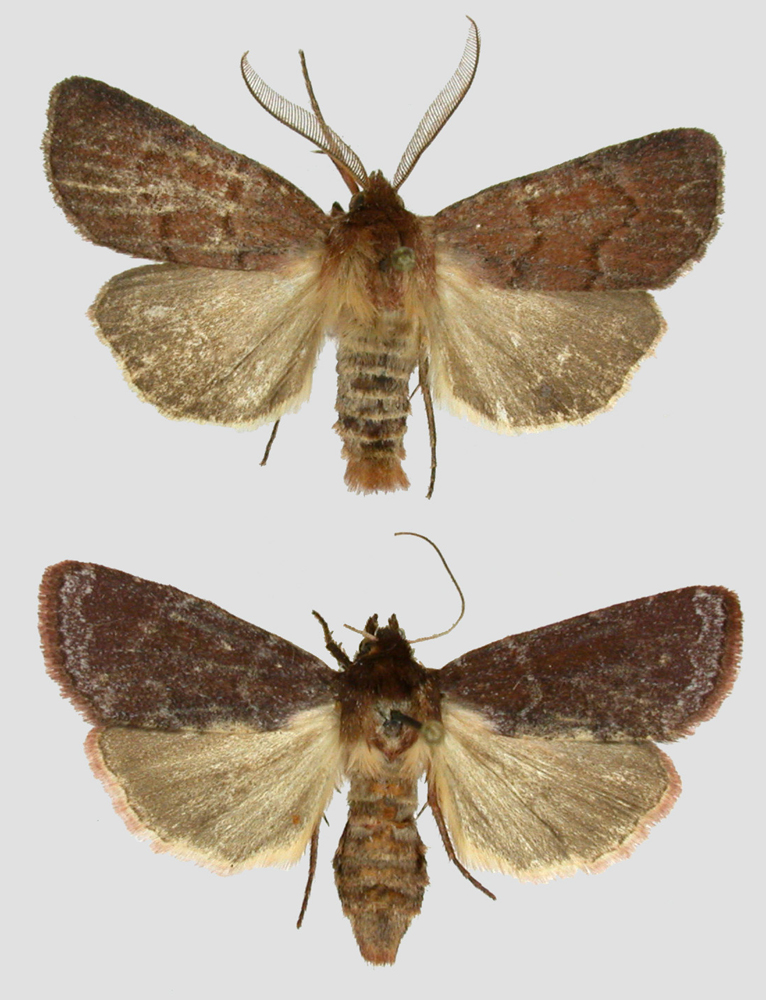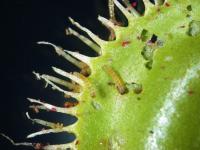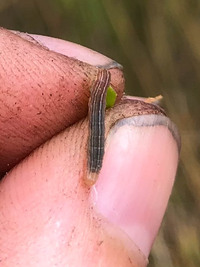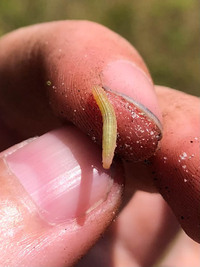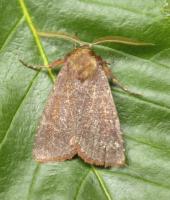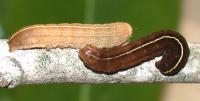Taxonomy
Superfamily:
Family: Subfamily: Tribe: P3 Number: MONA Number: Other Common Name:
Comments: Hemipachnobia is a North American genus composed of two species, both of which have been recorded in eastern North Carolina. The genus Hemipachnobia was defined by McDunnough in 1929, with H. monochromatea designated as the type species (McDunnough, 1929; Lafontaine, 1998). Although Smith (1891) tentatively listed subporphyrea as a synonym of monochromatea , other authors treated the two species as belonging to separate genera until relatively recently (Hall and Sullivan, 2000).
Species Status: Hemipachnobia subporphyrea was described (as Mythimna subporphyrea ) by Walker (1858), based on an apparently now vanished male specimen in the British Museum (Lafontaine, 1998). This specimen, along with two additional females in the British Museum -- one now designated as a lectotype by Lafontaine (1998) -- were identified as having come from “Georgia” but no other collection data was given, including the identity of the collector. Forbes (1954) treated subporphyrea as a subspecies of monochromatea , although he probably never saw the type specimens of subporphyrea . Lafontaine (1998) was the first to formally recognize the two moths as separate species within Hemipachnobia , based at least partly on the discovery of genitalic differences by McCabe and Schweitzer (Hall and Sullivan, 2000).
Identification
Field Guide Descriptions: Not included in either field guide Online Resources: MPG , BugGuide , iNaturalist , Google , BAMONA , GBIF , BOLD Technical Description, Adults: Lafontaine (1998); Hall and Sullivan (2000)Technical Description, Immature Stages: Hall and Sullivan (2004); Wagner et al. (2011)
Adult Markings: Hemipachnobia subporphyrea is a medium-sized, purplish to reddish brown Noctuid. Head and thorax are concolorous with the ground color of the forewings, which varies from a wine-red shade (a sub-purple", as implied by the species name) to a somewhat rustier shade similar to that of H. monochromatea . Variable amounts of grayish or fuscous scales are mixed in with those of the ground color and there is also a variable but lesser amount of white scaling, both on the wings and thorax. The fuscous scales tend to be most prominent along the veins and in some specimens form conspicuous gray lines. The only obvious markings on the forewings of either species of Hemipachnobia are the antemedian and postmedian lines of the forewings; other spots and lines are completely obsolete,including the orbicular and reniform spots that are usually prominent in Noctuids. The antemedian and postmedian are composed of scales that are either only slightly darker than the ground color, or are a distinctly darker, more fuscous shade than the ground color. Both lines tend to be bordered by white scales, which precede the antemedian and follow the postmedian. In some specimens, the lines are indicated primarily by the white scales (Hall and Sullivan, 2000). Lafontaine (1998) stated that the postmedian is less serrated in monochromatea than in subporphyrea , but in several specimens examined by Hall and Sullivan (2000), the postmedian was as even, or more so, in subporphyrea than in monochromatea . Apart from size, which appears to be consistently different between the two species, other features of the wing patterns overlap at least in some specimens, and we recommend that their identities be established through dissection of the males. Within the range of H. subporphyrea , only a few other spring-flying moths are even remotely similar. Cerastis tenebrifera , which flies about a month earlier in the spring than H. subporphyrea , has bipectinate antennae in the males but is a much deeper maroon than Hemipachnobia and has conspicuous, pale orbicular and reniform spots. Trichosilia manifesta , which flies at the same time as H. subporphyrea , also has bipectinate antennae in the males and has a reddish color phase that resembles Hemipachnobia to some extent. The dark orbicular and solid reniform spots possessed by this moth, however, easily distinguish it from Hemipachnobia , as do the distinctive traits of the tribe Agrotini, to which this species belongs.
Adult Structural Features: The differences separating males of subporphyrea and monochromatea were discovered by Timothy McCabe and Dale Schweitzer (Schweitzer, 1996) and were formally described and illustrated by Lafontaine (1998). The valve in male subporphyrea has three prominent distal projections, while the valve in monochromatea has only a single distal projection. The juxta of subporphyrea has a triangular, wedge shaped posterior projection, while the juxta of monochromatea , possesses a narrowly conical posterior projection. According to Lafontaine (1998), key differences also separate the females of subporphyrea and monochromatea , with the ductus bursae heavily sclerotized and anteriorly enlarged in subporphyrea and lightly sclerotized and anteriorly tapered in monochromatea .
Adult ID Requirements: Identifiable from good quality photos of unworn specimens.
Immatures and Development: In a rearing study conducted by Hall and Sullivan (2004), eggs obtained from a wild-caught female were opalescent white and sculptured dorso-ventrally with approximately 35 narrow ribs (larvae were photographed in each instar. First instar larvae typically have a yellowish-brown ground color. No lines are evident in this stage but there are rows of conspicuous blackish tubercles on each segment, out of which grow long, dark setae. The tubercles on the second and third thoracic segments are arranged in a single file, but there are two rows on the first thoracic and on all the abdominal segments, with the tubercles forming an alternating series between them. Second instar larvae are quite different in appearance. The ground color is now a coral pink. The tubercles are less prominent but still present and there are now several light lines running down the length of the body. In addition to a prominent mid-dorsal line, there are two well-marked sub-dorsal lines and a lateral line just above the prolegs. By the end of this instar, the larvae have taken on the thickened appearance typical of cutworms and show some degree of differentiation between a darker dorsal surface and lighter sides. Additional light lines may also be present in between the more prominent lines developed earlier. Third instar larvae are still somewhat translucent, like the earlier instars. The head is pinkish ivory with black ocelli. The ground color of the body is initially a fairly uniform light peach color but later becomes more divided into a series of green and tan stripes. The dorsal, subdorsal and lateral stripes are still ivory in color. The dorsal and lateral stripes are still prominent, and as in the later stages of the second instar, there are now two prominent lateral lines. The subdorsal stripes still visible but are relatively less well marked than the dorsal of lateral stripes. All ivory longitudinal lines are bordered on both sides by brown lines except the lateral line which has none on the ventral side. Between the subdorsal and lateral longitudinal stripes there are 3 cream stripes and 4 darker brown, with the stripe above the lateral lines typically darker than the rest. The 8th abdominal spiracle is the largest followed by the thoracic spiracle and then the other abdominal spiracles. The prolegs are rose colored and tipped with a grey spot. There are also grey spots above them on the body. The prolegs get slightly larger posteriorly. The ventral color of the abdomen is light tan. Fourth through sixth instars are generally browner and more opaque than the earlier stages and the subdorsal ivory lines more obscure, if present at all. Otherwise the pattern remain fairly constant, with some inter-individual differences.. The mid-dorsal line and the double lateral lines remain prominent features. The yellow mid-dorsal stripe is bordered laterally with brownish-black blotching running more-or-less continuously from the head to the anus. The same blotching repeats ventrally of the subdorsal pale line to the spiracles, which are black. The blotching gives a striped appearance to the body. Ventral of the spiracles, the coloration is a light tan with occasional specks and blotching. In some cases, the tan color of the ventrum extends well up on the sides and, along with the two light lateral stripes, gives the body a two-toned appearance, with a darker dorsum and lighter flanks. In other cases, the lighter area on the sides is more confined (perhaps related to amount of feeding?). The head is tan with blotches of very small speckles in an asymmetrical pattern. The labrum is paler, clear of markings and pinkish cream in color. The ommatidia are ruby colored or black. The larvae are extremely slow growing, as was noted by David Stephan, the first to rear this species. No diapause was observed; larvae fed throughout the entire study period. This contrasts with the behavior of its congener, H. monochromatea , which enters a diapause in the second instar (T. McCabe, pers. comm.). Unfortunately, none of the larvae ever pupated.
Larvae ID Requirements: Identifiable from close inspection of specimens or by DNA analysis.

 »
»